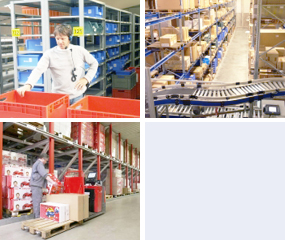
Manual warehouses / storage systems are storage locations and racking systems which are not accessed by automated systems, but operated by humans. Such warehouses can be narrow aisle warehouses, manual pallet racks or shelf storage systems. Such installations can be found with Big, Spinner, Marburger Tapeten, Riegler and other customers. In most cases, access to the storage locations is ensured through the "man-to-goods" principle. Especially in narrow aisle warehouses, however, you can also find order picking stations where goods are collected or made available (goods-to-man).
Manual warehouse and its special features
The general warehouse topology and the coordinate system do not differ from automatic warehouses. With the latter, merely the automation in terms of the operating device is fixed. Transport control is identical as well. However, when the man-to-goods principle is applied, no route optimization take place like in the case of an AS/RS, but routes can be saved that describe zig-zag, loops, U-courses and any other sequence. Manual warehouses can also be supported by conveyors ensuring material supply and disposal. Accordingly, handover positions and zones/stations are configured and which storage areas and aisles they operate. In most cases, processing takes place without vouchers (RF, voice) or with storage and picking documents which then are reported back.
Several load handling attachments
The control system and the MFC (material flow computer) are able to use several load handling attachments (and multiple load handling attachments) in an optimal manner. Corresponding installations with pallet AS/RS are in use at Rotho and Marburger Tapeten.
Route optimization through several load handling attachments
In case of several load handling attachments accumulating runs are possible that allow a high throughput even with slower devices. In X-direction, the AS/RS feature two load handling attachments. Order planning is done according to the route optimization by building packages (transport sequences) to place an order with the AS/RS. During this process, both load handling attachments are considered. If no second order exists at the time the order is allocated (only one load handling attachment occupied), the transport orders are again read after taking up the first loading unit to account for changes. It is also taken into account that possibly not all storage locations or handover positions to the conveyor system can be reached by both load handling attachments (due to the racking design). Their sphere of action is defined by configuring the load handling attachments. In case one load handling attachment fails (defective), the configuration also allows changing the settings such that orders are assigned to the AS/RS correspondingly with only one load handling attachment. Operating such devices is possible in automatic small parts warehouses and high-bay warehouses.